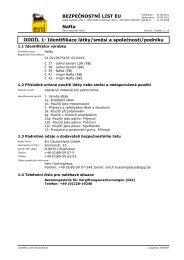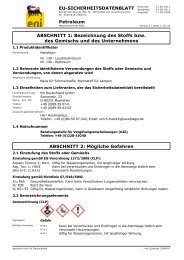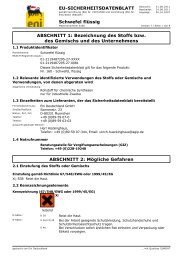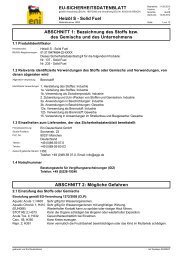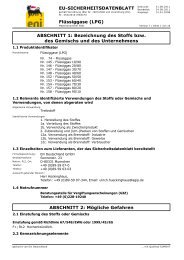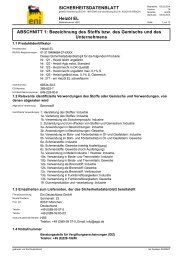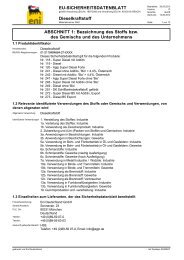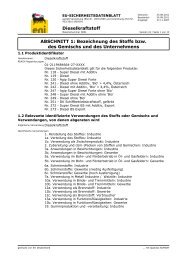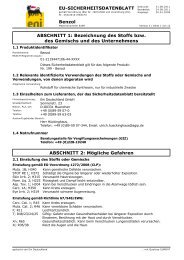EU-SICHERHEITSDATENBLATT CLO (Claryfied Oil) ABSCHNITT 1 ...
EU-SICHERHEITSDATENBLATT CLO (Claryfied Oil) ABSCHNITT 1 ...
EU-SICHERHEITSDATENBLATT CLO (Claryfied Oil) ABSCHNITT 1 ...
Create successful ePaper yourself
Turn your PDF publications into a flip-book with our unique Google optimized e-Paper software.
Heavy Fuel <strong>Oil</strong> Componentsthe required removal efficiency (%)If discharging to domestic sewage treatment plant, provide the required 0.0onsite wastewater removal efficiency of (%)Organisation measures to prevent/limit release from siteDo not apply industrial sludge to natural soils [OMS2]. Sludge should be incinerated, contained orreclaimed [OMS3].Conditions and measures related to municipal sewage treatment plantEstimated substance removal from wastewater via domestic sewage 88.8treatment (%)Total efficiency of removal from wastewater after onsite and offsite 88.8(domestic treatment plant) RMMs (%)Maximum allowable site tonnage (M Safe ) based on release following total 2.3e6wastewater treatment removal (kg/d)Assumed domestic sewage treatment plant flow (m 3 /d) 10000Conditions and measures related to external treatment of waste for disposalDuring manufacturing no waste of the substance is generated to treat [ETW4].Conditions and measures related to external recovery of wasteDuring manufacturing no waste of the substance is generated to recover [ERW2].Additional information on the basis for the allocation of the indentified OCs and RMMs iscontained in PETRORISK file in IUCLID Section 13.Section 3 Exposure Estimation3.1. HealthThe ECETOC TRA tool has been used to estimate workplace exposures unless otherwise indicated.G21.3.2. EnvironmentThe Hydrocarbon Block Method has been used to calculate environmental exposure with the Petroriskmodel [EE2].Section 4 Guidance to check compliance with the Exposure Scenario4.1. HealthPredicted exposures are not expected to exceed the DN(M)EL when the Risk ManagementMeasures/Operational Conditions outlined in Section 2 are implemented. G22.Where other Risk Management Measures/Operational Conditions are adopted, then users shouldensure that risks are managed to at least equivalent levels. G23.Available hazard data do not enable the derivation of a DNEL for carcinogenic effects. G33. Availablehazard data do not support the need for a DNEL to be established for other health effects. G36. RiskManagement Measures are based on qualitative risk characterisation. G37.4.2. EnvironmentGuidance is based on assumed operating conditions which may not be applicable to all sites; thus,scaling may be necessary to define appropriate site-specific risk management measures [DSU1].Required removal efficiency for wastewater can be achieved using onsite/offsite technologies, eitheralone or in combination [DSU2]. Required removal efficiency for air can be achieved using onsitetechnologies, either alone or in combination [DSU3]. Further details on scaling and controltechnologies are provided in SpERC factsheet (http://cefic.org/en/reach-for-industries-libraries.html)[DSU4]. Scaled assessments for <strong>EU</strong> refineries have been performed using site-specific data and areattached in PETRORISK file in IUCLID Section 13 – “Site-Specific Production” worksheet [DSU6]. Forrefinery sites where scaling revealed a condition of unsafe use (i.e., RCRs > 1), a site-specificchemical safety assessment was required [DSU8]. Consequently a Tier 2 assessment was performedin an attempt to refine conservative exposure assumptions and improve risk estimates. The Tier 2analysis demonstrates that no refineries have RCRs>1 (see Appendix 4 and PETRORISK file inIUCLID section 13 – "Tier 2 Site Specific Production worksheet").2010-08-10 CSR 122




